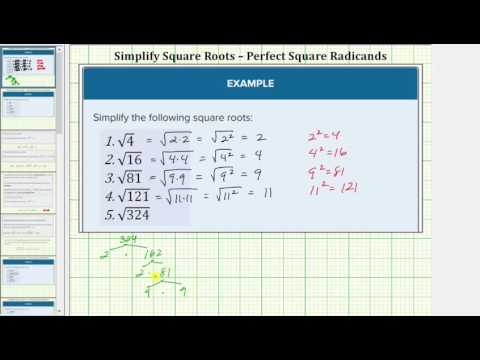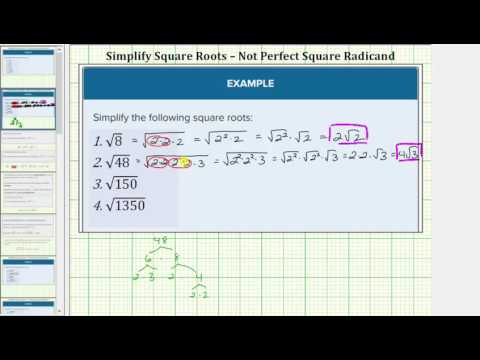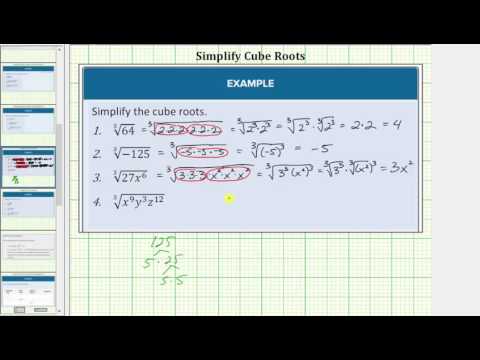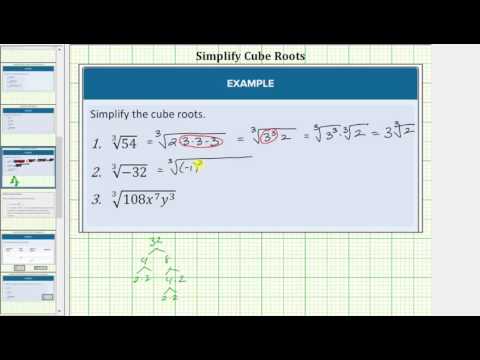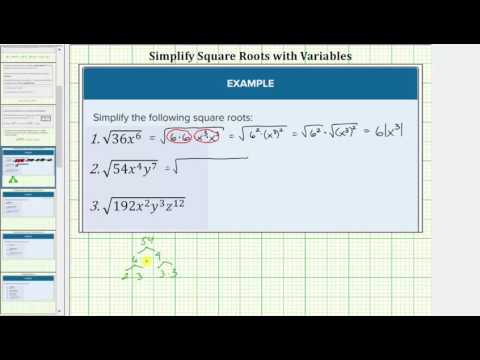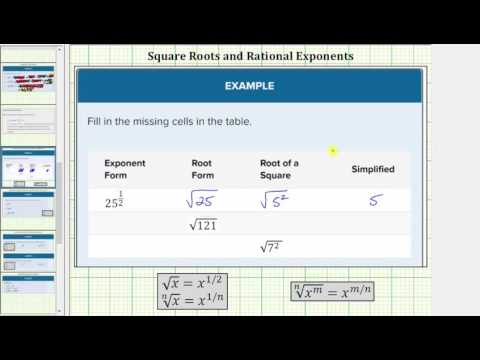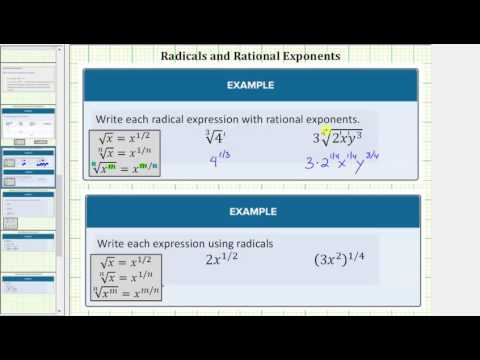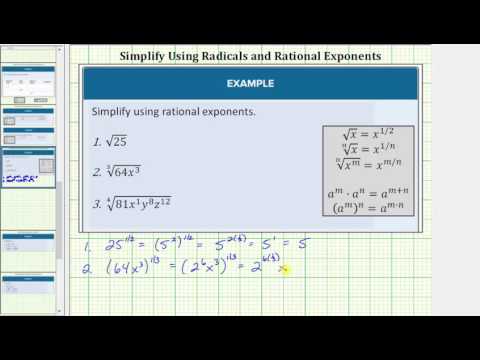8.2: Identify and Simplify Roots
( \newcommand{\kernel}{\mathrm{null}\,}\)
Learning Objectives
- Square Roots
- Use square root notation to write principal square roots
- Simplify principal square roots using factorization
- Cube Roots
- Use cube root notation to write cube roots
- Simplify cube roots using factorization
- Simplify Square Roots
- Simplify square roots with variables
- Determine when a simplified root needs an absolute value
- Rational Exponents
- Convert between radical and exponent notation
- Use the laws of exponents to simplify expressions with rational exponents
- Use rational exponents to simplify radical expressions
We know how to square a number:
(−5)2=25
Taking a square root is the opposite of squaring so we can make these statements:
- 5 is the nonngeative square root of 25
- -5 is the negative square root of 25
Find the square roots of the following numbers:
- 36
- 81
- -49
- 0
- We want to find a number whose square is 36. 62=36 therefore, the nonnegative square root of 36 is 6 and the negative square root of 36 is -6
- We want to find a number whose square is 81. 92=81 therefore, the nonnegative square root of 81 is 9 and the negative square root of 81 is -9
- We want to find a number whose square is -49. When you square a real number, the result is always positive. Stop and think about that for a second. A negative number times itself is positive, and a positive number times itself is positive. Therefore, -49 does not have square roots, there are no real number solutions to this question.
- We want to find a number whose square is 0. 02=0 therefore, the nonnegative square root of 0 is 0. We do not assign 0 a sign, so it has only one square root, and that is 0.
The notation that we use to express a square root for any real number, a, is as follows:
Writing a Square Root
The symbol for the square root is called a radical symbol. For a real number, a the square root of a is written as √a
The number that is written under the radical symbol is called the radicand.
By definition, the square root symbol, √5 always means to find the nonnegative root, called the principal root.
√a is defined for a>0
Let’s do an example similar to the example from above, this time using square root notation. Note that using the square root notation means that you are only finding the principal root – the nonnegative root.
Example
Simplify the following square roots:
- √16
- √9
- √−9
- √52
[reveal-answer q=”614386″]Show Solution[/reveal-answer]
[hidden-answer a=”614386″]
- √16=4. We only write the nonnegative root because that is how the root symbol is defined.
- √9=3. We only write the nonnegative root because that is how the root symbol is defined.
- √−9. We are looking for a number whose square is -9. There are no real numbers whose square is -9, so this radical is not a real number.
- 52. We already have the number whose square is 52, it’s 5!
[/hidden-answer]
The last problem in the previous example shows us an important relationship between squares and square roots, and we can summarize it as follows:
The square root of a square
For a nonnegative real number, a, √a2=a
In the video that follows, we simplify more square roots using the fact that √a2=a means finding the principal square root.
What if you are working with a number whose square you do not know right away? We can use factoring and the product rule for square roots to find square roots such as √225.
The Product Rule for Square Roots
Given that a and b are nonnegative real numbers, √a⋅b=√a⋅√b
In the examples that follow we will bring together these ideas to simplify square roots of numbers that are not obvious at first glance:
- square root of a square,
- the product rule for square roots
- factoring
Example
Simplify √144
[reveal-answer q=”620082″]Show Solution[/reveal-answer]
[hidden-answer a=”620082″]
Determine the prime factors of 144.
√144√2⋅72√2⋅2⋅36√2⋅2⋅2⋅18√2⋅2⋅2⋅2⋅9√2⋅2⋅2⋅2⋅3⋅3
Because we are finding a square root, we regroup these factors into squares.
√22⋅22⋅32
Now we can use the product rule for square roots and the square root of a square idea to finish finding the square root.
√22⋅22⋅32=√22⋅√22⋅√32=2⋅3⋅2=12
Answer
√144=12
[/hidden-answer]
Example
Simplify √225
[reveal-answer q=”686109″]Show Solution[/reveal-answer]
[hidden-answer a=”686109″]
First, factor 225:
√225=√5⋅45=√5⋅5⋅9=√5⋅5⋅3⋅3
Because we are finding a square root, we regroup these factors into squares. Finish simplifying with the product rule for roots, and the square of a square idea.
√52⋅32=√52⋅√32=5⋅3=15
Answer
√225=15
[/hidden-answer]
![]() Caution! The square root of a product rule applies when you have multiplication ONLY under the square root. You cannot apply the rule to sums:
Caution! The square root of a product rule applies when you have multiplication ONLY under the square root. You cannot apply the rule to sums:
√a+b≠√a+√b
Prove this to yourself with some real numbers: let a = 64 and b = 36, then use the order of operations to simplify each expression.
√64+36=√100=10√64+√36=8+6=1410≠14
So far, you have seen examples that are perfect squares. That is, each is a number whose square root is an integer. But many radical expressions are not perfect squares. Some of these radicals can still be simplified by finding perfect square factors. The example below illustrates how to factor the radicand, looking for pairs of factors that can be expressed as a square.
Example
Simplify. √63
[reveal-answer q=”908978″]Show Solution[/reveal-answer]
[hidden-answer a=”908978″]Factor 63
√7⋅3⋅3
Regroup factors into squares
√7⋅32
Finish simplifying with the product rule for roots, and the square of a square idea.
√7⋅32=√7⋅√32=√7⋅3
Since 7 is prime and we can’t write it as a square, it will have to stay under the radical sign. As a matter of convention, we write the constant, 3, in front of the radical. This helps the reader know that the 3 is not under the radical anymore.
3⋅√7
Answer
√63=3√7
[/hidden-answer]
The final answer 3√7 may look a bit odd, but it is in simplified form. You can read this as “three radical seven” or “three times the square root of seven.”

In the next example, we take a bit of a shortcut by making use of the common squares we know, instead of using prime factors. It helps to have the squares of the numbers between 0 and 10 fresh in your mind to make simplifying radicals faster.
- 02=0
- 22=4
- 32=9
- 42=16
- 52=25
- 62=36
- 72=49
- 82=64
- 92=81
- 102=100
Example
Simplify. √2,000
[reveal-answer q=”932245″]Show Solution[/reveal-answer]
[hidden-answer a=”932245″]Factor 2,000 to find perfect squares.
√100⋅20=√100⋅4⋅5
100=102,4=22
\boldsymbol{\begin{array}\sqrt{100\cdot 4\cdot 5}\\\\= \sqrt{10^2\cdot 4^2\cdot 5}\\\\=\sqrt{10^2}\cdot\sqrt{4^2}\cdot\sqrt{5}\\\\=10\cdot4\cdot\sqrt{5}}
Multiply.
20⋅√5
Answer
√2,000=20√5
[/hidden-answer]
In this last video, we show examples of simplifying radicals that are not perfect squares.
Cube Roots

While square roots are probably the most common radical, you can also find the third root, the fifth root, the 10th root, or really any other nth root of a number. Just as the square root is a number that, when squared, gives the radicand, the cube root is a number that, when cubed, gives the radicand.
Find the cube roots of the following numbers:
- 27
- 8
- -8
- 0
- We want to find a number whose cube is 27. 9=32, so 3/cdot3/cdot3=33=27
- We want to find a number whose cube is 8. 2⋅2⋅2=8 the cube root of 8 is 2.
- We want to find a number whose cube is -8. We know 2 is the cube root of 8, so maybe we can try -2. −2⋅−2⋅−2=−8, so the cube root of -8 is -2. This is different from square roots because multiplying three negative numbers together results in a negative number.
- We want to find a number whose cube is 0. 0 by itself, you will always get 0.
The cube root of a number is written with a small number 3, called the index, just outside and above the radical symbol. It looks like \boldsymbol{\sqrt[3]}. This little 3 distinguishes cube roots from square roots which are written without a small number outside and above the radical symbol.
3√x, three times the square root of x. They may look similar at first, but they lead you to much different expressions!
We can also use factoring to simplify cube roots such as 3√125. You can read this as “the third root of 125” or “the cube root of 125.” To simplify this expression, look for a number that, when multiplied by itself two times (for a total of three identical factors), equals 125. Let’s factor 125 and find that number.
Example
Simplify. 3√125
[reveal-answer q=”517592″]Show Solution[/reveal-answer]
[hidden-answer a=”517592″]125 ends in 5, so you know that 5 is a factor. Expand 125 into 5⋅25.
3√5⋅25
Factor 25 into 5 and 5.
3√5⋅5⋅5
The factors are 53.
\(\sqrt[3]
Callstack:
at (Courses/Lumen_Learning/Beginning_Algebra_(Lumen)/08:_Roots_and_Rational_Exponents/8.02:_Identify_and_Simplify_Roots), /content/body/div[10]/div[3]/p[7]/span, line 1, column 3
Answer
3√125=5
[/hidden-answer]
The prime factors of 125 are 53. The cube root of a cubed number is the number itself, so \(\sqrt[3]
Callstack:
at (Courses/Lumen_Learning/Beginning_Algebra_(Lumen)/08:_Roots_and_Rational_Exponents/8.02:_Identify_and_Simplify_Roots), /content/body/div[10]/div[3]/div/p[3]/span, line 1, column 3
Here’s an example of how to simplify a radical that is not a perfect cube.
Example
Simplify. \(\sqrt[3]{32
Callstack:
at (Courses/Lumen_Learning/Beginning_Algebra_(Lumen)/08:_Roots_and_Rational_Exponents/8.02:_Identify_and_Simplify_Roots), /content/body/div[10]/div[4]/p[1]/span, line 1, column 2
[reveal-answer q=”617053″]Show Solution[/reveal-answer]
[hidden-answer a=”617053″]Factor 32 into prime factors.
\(\sqrt[3]{2\cdot 2\cdot 2\cdot 2\cdot 2\cdot
Callstack:
at (Courses/Lumen_Learning/Beginning_Algebra_(Lumen)/08:_Roots_and_Rational_Exponents/8.02:_Identify_and_Simplify_Roots), /content/body/div[10]/div[4]/p[3]/span, line 1, column 2
Since you are looking for the cube root, you need to find factors that appear 3 times under the radical. Rewrite \(
Callstack:
at (Courses/Lumen_Learning/Beginning_Algebra_(Lumen)/08:_Roots_and_Rational_Exponents/8.02:_Identify_and_Simplify_Roots), /content/body/div[10]/div[4]/p[4]/span, line 1, column 2
\(\sqrt[3]
Callstack:
at (Courses/Lumen_Learning/Beginning_Algebra_(Lumen)/08:_Roots_and_Rational_Exponents/8.02:_Identify_and_Simplify_Roots), /content/body/div[10]/div[4]/p[5]/span, line 1, column 3
Rewrite \(
Callstack:
at (Courses/Lumen_Learning/Beginning_Algebra_(Lumen)/08:_Roots_and_Rational_Exponents/8.02:_Identify_and_Simplify_Roots), /content/body/div[10]/div[4]/p[6]/span[1], line 1, column 2
Callstack:
at (Courses/Lumen_Learning/Beginning_Algebra_(Lumen)/08:_Roots_and_Rational_Exponents/8.02:_Identify_and_Simplify_Roots), /content/body/div[10]/div[4]/p[6]/span[2], line 1, column 2
\(\sqrt[3]
Callstack:
at (Courses/Lumen_Learning/Beginning_Algebra_(Lumen)/08:_Roots_and_Rational_Exponents/8.02:_Identify_and_Simplify_Roots), /content/body/div[10]/div[4]/p[7]/span, line 1, column 3
Rewrite the expression as a product of multiple radicals.
\(\sqrt[3]
Callstack:
at (Courses/Lumen_Learning/Beginning_Algebra_(Lumen)/08:_Roots_and_Rational_Exponents/8.02:_Identify_and_Simplify_Roots), /content/body/div[10]/div[4]/p[9]/span[1], line 1, column 3
Callstack:
at (Courses/Lumen_Learning/Beginning_Algebra_(Lumen)/08:_Roots_and_Rational_Exponents/8.02:_Identify_and_Simplify_Roots), /content/body/div[10]/div[4]/p[9]/span[2], line 1, column 3
Callstack:
at (Courses/Lumen_Learning/Beginning_Algebra_(Lumen)/08:_Roots_and_Rational_Exponents/8.02:_Identify_and_Simplify_Roots), /content/body/div[10]/div[4]/p[9]/span[3], line 1, column 3
Simplify and multiply.
\(2\cdot \sqrt[3]{4}\cdot m\cdot \sqrt[3]
Callstack:
at (Courses/Lumen_Learning/Beginning_Algebra_(Lumen)/08:_Roots_and_Rational_Exponents/8.02:_Identify_and_Simplify_Roots), /content/body/div[10]/div[4]/p[11]/span, line 1, column 3
Answer
\(\sqrt[3]{32
Callstack:
at (Courses/Lumen_Learning/Beginning_Algebra_(Lumen)/08:_Roots_and_Rational_Exponents/8.02:_Identify_and_Simplify_Roots), /content/body/div[10]/div[4]/div/p[1]/span[1], line 1, column 2
Callstack:
at (Courses/Lumen_Learning/Beginning_Algebra_(Lumen)/08:_Roots_and_Rational_Exponents/8.02:_Identify_and_Simplify_Roots), /content/body/div[10]/div[4]/div/p[1]/span[2], line 1, column 2
[/hidden-answer]
In the example below, we use the following idea:
\(\sqrt[3]
Callstack:
at (Courses/Lumen_Learning/Beginning_Algebra_(Lumen)/08:_Roots_and_Rational_Exponents/8.02:_Identify_and_Simplify_Roots), /content/body/div[10]/div[4]/div/p[4]/span, line 1, column 6
to simplify the radical. You do not have to do this, but it may help you recognize cubes more easily when they are nonnegative.
Example
Simplify. \(\sqrt[3]{-27
Callstack:
at (Courses/Lumen_Learning/Beginning_Algebra_(Lumen)/08:_Roots_and_Rational_Exponents/8.02:_Identify_and_Simplify_Roots), /content/body/div[10]/div[5]/p[1]/span[1], line 1, column 2
Callstack:
at (Courses/Lumen_Learning/Beginning_Algebra_(Lumen)/08:_Roots_and_Rational_Exponents/8.02:_Identify_and_Simplify_Roots), /content/body/div[10]/div[5]/p[1]/span[2], line 1, column 2
[reveal-answer q=”670300″]Show Solution[/reveal-answer]
[hidden-answer a=”670300″]Factor the expression into cubes.
Separate the cubed factors into individual radicals.
\(\begin{array}{r}\sqrt[3]{-1\cdot 27\cdot
Callstack:
at (Courses/Lumen_Learning/Beginning_Algebra_(Lumen)/08:_Roots_and_Rational_Exponents/8.02:_Identify_and_Simplify_Roots), /content/body/div[10]/div[5]/p[4]/span[1], line 1, column 2
Callstack:
at (Courses/Lumen_Learning/Beginning_Algebra_(Lumen)/08:_Roots_and_Rational_Exponents/8.02:_Identify_and_Simplify_Roots), /content/body/div[10]/div[5]/p[4]/span[2], line 1, column 2
Callstack:
at (Courses/Lumen_Learning/Beginning_Algebra_(Lumen)/08:_Roots_and_Rational_Exponents/8.02:_Identify_and_Simplify_Roots), /content/body/div[10]/div[5]/p[4]/span[3], line 1, column 6
Callstack:
at (Courses/Lumen_Learning/Beginning_Algebra_(Lumen)/08:_Roots_and_Rational_Exponents/8.02:_Identify_and_Simplify_Roots), /content/body/div[10]/div[5]/p[4]/span[4], line 1, column 6
Callstack:
at (Courses/Lumen_Learning/Beginning_Algebra_(Lumen)/08:_Roots_and_Rational_Exponents/8.02:_Identify_and_Simplify_Roots), /content/body/div[10]/div[5]/p[4]/span[5], line 1, column 5
Callstack:
at (Courses/Lumen_Learning/Beginning_Algebra_(Lumen)/08:_Roots_and_Rational_Exponents/8.02:_Identify_and_Simplify_Roots), /content/body/div[10]/div[5]/p[4]/span[6], line 1, column 3
Callstack:
at (Courses/Lumen_Learning/Beginning_Algebra_(Lumen)/08:_Roots_and_Rational_Exponents/8.02:_Identify_and_Simplify_Roots), /content/body/div[10]/div[5]/p[4]/span[7], line 1, column 3
Simplify the cube roots.
−1⋅3⋅x⋅y⋅3√x
Answer
\(\sqrt[3]{-27
Callstack:
at (Courses/Lumen_Learning/Beginning_Algebra_(Lumen)/08:_Roots_and_Rational_Exponents/8.02:_Identify_and_Simplify_Roots), /content/body/div[10]/div[5]/div/p[1]/span[1], line 1, column 2
Callstack:
at (Courses/Lumen_Learning/Beginning_Algebra_(Lumen)/08:_Roots_and_Rational_Exponents/8.02:_Identify_and_Simplify_Roots), /content/body/div[10]/div[5]/div/p[1]/span[2], line 1, column 2
[/hidden-answer]
In the video that follows, we show more examples if simplifying cube roots.
You could check your answer by performing the inverse operation. If you are right, when you cube \(-27
Callstack:
at (Courses/Lumen_Learning/Beginning_Algebra_(Lumen)/08:_Roots_and_Rational_Exponents/8.02:_Identify_and_Simplify_Roots), /content/body/div[10]/div[5]/div/p[4]/span[1], line 1, column 2
Callstack:
at (Courses/Lumen_Learning/Beginning_Algebra_(Lumen)/08:_Roots_and_Rational_Exponents/8.02:_Identify_and_Simplify_Roots), /content/body/div[10]/div[5]/div/p[4]/span[2], line 1, column 2
\(\begin{array}{l}\left( -3xy\sqrt[3]{x} \right)\left( -3xy\sqrt[3]{x} \right)\left( -3xy\sqrt[3]{x} \right)\\-3\cdot -3\cdot -3\cdot x\cdot x\cdot x\cdot y\cdot y\cdot y\cdot \sqrt[3]{x}\cdot \sqrt[3]{x}\cdot \sqrt[3]{x}\\-27\cdot
Callstack:
at (Courses/Lumen_Learning/Beginning_Algebra_(Lumen)/08:_Roots_and_Rational_Exponents/8.02:_Identify_and_Simplify_Roots), /content/body/div[10]/div[5]/div/p[5]/span[1], line 1, column 2
Callstack:
at (Courses/Lumen_Learning/Beginning_Algebra_(Lumen)/08:_Roots_and_Rational_Exponents/8.02:_Identify_and_Simplify_Roots), /content/body/div[10]/div[5]/div/p[5]/span[2], line 1, column 2
Callstack:
at (Courses/Lumen_Learning/Beginning_Algebra_(Lumen)/08:_Roots_and_Rational_Exponents/8.02:_Identify_and_Simplify_Roots), /content/body/div[10]/div[5]/div/p[5]/span[3], line 1, column 3
Callstack:
at (Courses/Lumen_Learning/Beginning_Algebra_(Lumen)/08:_Roots_and_Rational_Exponents/8.02:_Identify_and_Simplify_Roots), /content/body/div[10]/div[5]/div/p[5]/span[4], line 1, column 2
Callstack:
at (Courses/Lumen_Learning/Beginning_Algebra_(Lumen)/08:_Roots_and_Rational_Exponents/8.02:_Identify_and_Simplify_Roots), /content/body/div[10]/div[5]/div/p[5]/span[5], line 1, column 2
Callstack:
at (Courses/Lumen_Learning/Beginning_Algebra_(Lumen)/08:_Roots_and_Rational_Exponents/8.02:_Identify_and_Simplify_Roots), /content/body/div[10]/div[5]/div/p[5]/span[6], line 1, column 2
Callstack:
at (Courses/Lumen_Learning/Beginning_Algebra_(Lumen)/08:_Roots_and_Rational_Exponents/8.02:_Identify_and_Simplify_Roots), /content/body/div[10]/div[5]/div/p[5]/span[7], line 1, column 2
You can find the odd root of a negative number, but you cannot find the even root of a negative number. This means you can simplify the radicals 7√−2187, but you cannot simplify the radicals 6√−2,500.
Let’s look at another example.
Example
Simplify. \(\sqrt[3]{-24
Callstack:
at (Courses/Lumen_Learning/Beginning_Algebra_(Lumen)/08:_Roots_and_Rational_Exponents/8.02:_Identify_and_Simplify_Roots), /content/body/div[10]/div[6]/p[1]/span, line 1, column 2
[reveal-answer q=”473861″]Show Solution[/reveal-answer]
[hidden-answer a=”473861″]Factor −1 and 8 are the perfect cubes.
\(\sqrt[3]{-1\cdot 8\cdot 3\cdot
Callstack:
at (Courses/Lumen_Learning/Beginning_Algebra_(Lumen)/08:_Roots_and_Rational_Exponents/8.02:_Identify_and_Simplify_Roots), /content/body/div[10]/div[6]/p[3]/span, line 1, column 2
Factor variables. You are looking for cube exponents, so you factor a3 and a2.
\(\sqrt[3]
Callstack:
at (Courses/Lumen_Learning/Beginning_Algebra_(Lumen)/08:_Roots_and_Rational_Exponents/8.02:_Identify_and_Simplify_Roots), /content/body/div[10]/div[6]/p[5]/span, line 1, column 6
Separate the factors into individual radicals.
\(\sqrt[3]
Callstack:
at (Courses/Lumen_Learning/Beginning_Algebra_(Lumen)/08:_Roots_and_Rational_Exponents/8.02:_Identify_and_Simplify_Roots), /content/body/div[10]/div[6]/p[7]/span[1], line 1, column 6
Callstack:
at (Courses/Lumen_Learning/Beginning_Algebra_(Lumen)/08:_Roots_and_Rational_Exponents/8.02:_Identify_and_Simplify_Roots), /content/body/div[10]/div[6]/p[7]/span[2], line 1, column 3
Callstack:
at (Courses/Lumen_Learning/Beginning_Algebra_(Lumen)/08:_Roots_and_Rational_Exponents/8.02:_Identify_and_Simplify_Roots), /content/body/div[10]/div[6]/p[7]/span[3], line 1, column 3
Callstack:
at (Courses/Lumen_Learning/Beginning_Algebra_(Lumen)/08:_Roots_and_Rational_Exponents/8.02:_Identify_and_Simplify_Roots), /content/body/div[10]/div[6]/p[7]/span[4], line 1, column 2
Simplify, using the property \(\sqrt[3]
Callstack:
at (Courses/Lumen_Learning/Beginning_Algebra_(Lumen)/08:_Roots_and_Rational_Exponents/8.02:_Identify_and_Simplify_Roots), /content/body/div[10]/div[6]/p[8]/span, line 1, column 3
\(-1\cdot 2\cdot a\cdot \sqrt[3]{3\cdot
Callstack:
at (Courses/Lumen_Learning/Beginning_Algebra_(Lumen)/08:_Roots_and_Rational_Exponents/8.02:_Identify_and_Simplify_Roots), /content/body/div[10]/div[6]/p[9]/span, line 1, column 2
This is the simplest form of this expression; all cubes have been pulled out of the radical expression.
\(-2a\sqrt[3]{3
Callstack:
at (Courses/Lumen_Learning/Beginning_Algebra_(Lumen)/08:_Roots_and_Rational_Exponents/8.02:_Identify_and_Simplify_Roots), /content/body/div[10]/div[6]/p[11]/span, line 1, column 2
Answer
\(\sqrt[3]{-24
Callstack:
at (Courses/Lumen_Learning/Beginning_Algebra_(Lumen)/08:_Roots_and_Rational_Exponents/8.02:_Identify_and_Simplify_Roots), /content/body/div[10]/div[6]/div[1]/p[1]/span[1], line 1, column 2
Callstack:
at (Courses/Lumen_Learning/Beginning_Algebra_(Lumen)/08:_Roots_and_Rational_Exponents/8.02:_Identify_and_Simplify_Roots), /content/body/div[10]/div[6]/div[1]/p[1]/span[2], line 1, column 2
[/hidden-answer]
The steps to consider when simplifying a radical are outlined below.
Simplifying a radical
When working with exponents and radicals:
- If n is odd, \(\sqrt[n](click for details)=x\).
Callstack: at (Courses/Lumen_Learning/Beginning_Algebra_(Lumen)/08:_Roots_and_Rational_Exponents/8.02:_Identify_and_Simplify_Roots), /content/body/div[10]/div[6]/div[1]/div/div/ul/li[1]/span, line 1, column 3 - If n is even, \(\sqrt[n](click for details)=\left| x \right|\). (The absolute value accounts for the fact that if x is negative and raised to an even power, that number will be positive, as will the nth principal root of that number.)
Callstack: at (Courses/Lumen_Learning/Beginning_Algebra_(Lumen)/08:_Roots_and_Rational_Exponents/8.02:_Identify_and_Simplify_Roots), /content/body/div[10]/div[6]/div[1]/div/div/ul/li[2]/span, line 1, column 3
Example
Simplify. \(\sqrt{100
Callstack:
at (Courses/Lumen_Learning/Beginning_Algebra_(Lumen)/08:_Roots_and_Rational_Exponents/8.02:_Identify_and_Simplify_Roots), /content/body/div[10]/div[6]/div[2]/p[1]/span[1], line 1, column 2
Callstack:
at (Courses/Lumen_Learning/Beginning_Algebra_(Lumen)/08:_Roots_and_Rational_Exponents/8.02:_Identify_and_Simplify_Roots), /content/body/div[10]/div[6]/div[2]/p[1]/span[2], line 1, column 2
[reveal-answer q=”982628″]Show Solution[/reveal-answer]
[hidden-answer a=”982628″]Separate factors; look for squared numbers and variables. Factor 100 into 10⋅10.
\(\sqrt{10\cdot 10\cdot
Callstack:
at (Courses/Lumen_Learning/Beginning_Algebra_(Lumen)/08:_Roots_and_Rational_Exponents/8.02:_Identify_and_Simplify_Roots), /content/body/div[10]/div[6]/div[2]/p[3]/span[1], line 1, column 2
Callstack:
at (Courses/Lumen_Learning/Beginning_Algebra_(Lumen)/08:_Roots_and_Rational_Exponents/8.02:_Identify_and_Simplify_Roots), /content/body/div[10]/div[6]/div[2]/p[3]/span[2], line 1, column 2
Factor (y2)2.
\(\sqrt{10\cdot 10\cdot
Callstack:
at (Courses/Lumen_Learning/Beginning_Algebra_(Lumen)/08:_Roots_and_Rational_Exponents/8.02:_Identify_and_Simplify_Roots), /content/body/div[10]/div[6]/div[2]/p[5]/span[1], line 1, column 2
Callstack:
at (Courses/Lumen_Learning/Beginning_Algebra_(Lumen)/08:_Roots_and_Rational_Exponents/8.02:_Identify_and_Simplify_Roots), /content/body/div[10]/div[6]/div[2]/p[5]/span[2], line 1, column 3
Separate the squared factors into individual radicals.
\(\sqrt
Callstack:
at (Courses/Lumen_Learning/Beginning_Algebra_(Lumen)/08:_Roots_and_Rational_Exponents/8.02:_Identify_and_Simplify_Roots), /content/body/div[10]/div[6]/div[2]/p[7]/span[1], line 1, column 4
Callstack:
at (Courses/Lumen_Learning/Beginning_Algebra_(Lumen)/08:_Roots_and_Rational_Exponents/8.02:_Identify_and_Simplify_Roots), /content/body/div[10]/div[6]/div[2]/p[7]/span[2], line 1, column 3
Callstack:
at (Courses/Lumen_Learning/Beginning_Algebra_(Lumen)/08:_Roots_and_Rational_Exponents/8.02:_Identify_and_Simplify_Roots), /content/body/div[10]/div[6]/div[2]/p[7]/span[3], line 1, column 4
Take the square root of each radical . Since you do not know whether x is positive or negative, use |x| to account for both possibilities, thereby guaranteeing that your answer will be positive.
10⋅|x|⋅y2
Simplify and multiply.
10|x|y2
Answer
\(\sqrt{100
Callstack:
at (Courses/Lumen_Learning/Beginning_Algebra_(Lumen)/08:_Roots_and_Rational_Exponents/8.02:_Identify_and_Simplify_Roots), /content/body/div[10]/div[6]/div[2]/div/p[1]/span[1], line 1, column 2
Callstack:
at (Courses/Lumen_Learning/Beginning_Algebra_(Lumen)/08:_Roots_and_Rational_Exponents/8.02:_Identify_and_Simplify_Roots), /content/body/div[10]/div[6]/div[2]/div/p[1]/span[2], line 1, column 2
Callstack:
at (Courses/Lumen_Learning/Beginning_Algebra_(Lumen)/08:_Roots_and_Rational_Exponents/8.02:_Identify_and_Simplify_Roots), /content/body/div[10]/div[6]/div[2]/div/p[1]/span[3], line 1, column 2
[/hidden-answer]
You can check your answer by squaring it to be sure it equals \(100
Callstack:
at (Courses/Lumen_Learning/Beginning_Algebra_(Lumen)/08:_Roots_and_Rational_Exponents/8.02:_Identify_and_Simplify_Roots), /content/body/div[10]/div[6]/div[2]/div/p[3]/span[1], line 1, column 2
Callstack:
at (Courses/Lumen_Learning/Beginning_Algebra_(Lumen)/08:_Roots_and_Rational_Exponents/8.02:_Identify_and_Simplify_Roots), /content/body/div[10]/div[6]/div[2]/div/p[3]/span[2], line 1, column 2
In the last video, we share examples of finding cube roots with negative radicands.
Simplify Square Roots with Variables
Radical expressions are expressions that contain radicals. Radical expressions come in many forms, from simple and familiar, such as\(\sqrt[3]{250
Callstack:
at (Courses/Lumen_Learning/Beginning_Algebra_(Lumen)/08:_Roots_and_Rational_Exponents/8.02:_Identify_and_Simplify_Roots), /content/body/div[11]/p/span, line 1, column 2

Simplifying Square Roots
Radical expressions will sometimes include variables as well as numbers. Consider the expression \(\sqrt{9
Callstack:
at (Courses/Lumen_Learning/Beginning_Algebra_(Lumen)/08:_Roots_and_Rational_Exponents/8.02:_Identify_and_Simplify_Roots), /content/body/div[12]/p[1]/span, line 1, column 2
Consider the expression \(\sqrt
Callstack:
at (Courses/Lumen_Learning/Beginning_Algebra_(Lumen)/08:_Roots_and_Rational_Exponents/8.02:_Identify_and_Simplify_Roots), /content/body/div[12]/p[2]/span, line 1, column 3
In the chart below, look along each row and determine whether the value of x is the same as the value of \(\sqrt
Callstack:
at (Courses/Lumen_Learning/Beginning_Algebra_(Lumen)/08:_Roots_and_Rational_Exponents/8.02:_Identify_and_Simplify_Roots), /content/body/div[12]/p[3]/span, line 1, column 3
After doing that for each row, look again and determine whether the value of |x|.
| x2 | |x| | ||
|---|---|---|---|
| −2 | 4 | 2 | 2 |
| 0 | 0 | 0 | 0 |
| 6 | 36 | 6 | 6 |
| 10 | 100 | 10 | 10 |
Notice—in cases where x is a negative number, √x2=|x|. You need to consider this fact when simplifying radicals that contain variables, because by definition √x2 is always nonnegative.
Taking the Square Root of a Radical Expression
When finding the square root of an expression that contains variables raised to a power, consider that √x2=|x|.
Examples: \(\sqrt{16
Callstack:
at (Courses/Lumen_Learning/Beginning_Algebra_(Lumen)/08:_Roots_and_Rational_Exponents/8.02:_Identify_and_Simplify_Roots), /content/body/div[12]/div[1]/div/p[2]/span[1], line 1, column 2
Callstack:
at (Courses/Lumen_Learning/Beginning_Algebra_(Lumen)/08:_Roots_and_Rational_Exponents/8.02:_Identify_and_Simplify_Roots), /content/body/div[12]/div[1]/div/p[2]/span[2], line 1, column 2
Let’s try it.
The goal is to find factors under the radical that are perfect squares so that you can take their square root.
Example
Simplify. \(\sqrt{9
Callstack:
at (Courses/Lumen_Learning/Beginning_Algebra_(Lumen)/08:_Roots_and_Rational_Exponents/8.02:_Identify_and_Simplify_Roots), /content/body/div[12]/div[2]/p[1]/span, line 1, column 2
[reveal-answer q=”41297″]Show Solution[/reveal-answer]
[hidden-answer a=”41297″]Factor to find identical pairs.
\(\sqrt{3\cdot 3\cdot
Callstack:
at (Courses/Lumen_Learning/Beginning_Algebra_(Lumen)/08:_Roots_and_Rational_Exponents/8.02:_Identify_and_Simplify_Roots), /content/body/div[12]/div[2]/p[3]/span[1], line 1, column 2
Callstack:
at (Courses/Lumen_Learning/Beginning_Algebra_(Lumen)/08:_Roots_and_Rational_Exponents/8.02:_Identify_and_Simplify_Roots), /content/body/div[12]/div[2]/p[3]/span[2], line 1, column 2
Rewrite the pairs as perfect squares, note how we use the power rule for exponents to simplify x32
\(\sqrt
Callstack:
at (Courses/Lumen_Learning/Beginning_Algebra_(Lumen)/08:_Roots_and_Rational_Exponents/8.02:_Identify_and_Simplify_Roots), /content/body/div[12]/div[2]/p[5]/span, line 1, column 3
Separate into individual radicals.
\(\sqrt
Callstack:
at (Courses/Lumen_Learning/Beginning_Algebra_(Lumen)/08:_Roots_and_Rational_Exponents/8.02:_Identify_and_Simplify_Roots), /content/body/div[12]/div[2]/p[7]/span[1], line 1, column 3
Callstack:
at (Courses/Lumen_Learning/Beginning_Algebra_(Lumen)/08:_Roots_and_Rational_Exponents/8.02:_Identify_and_Simplify_Roots), /content/body/div[12]/div[2]/p[7]/span[2], line 1, column 2
Simplify, using the rule that \(\sqrt
Callstack:
at (Courses/Lumen_Learning/Beginning_Algebra_(Lumen)/08:_Roots_and_Rational_Exponents/8.02:_Identify_and_Simplify_Roots), /content/body/div[12]/div[2]/p[8]/span, line 1, column 3
\(3\left|
Callstack:
at (Courses/Lumen_Learning/Beginning_Algebra_(Lumen)/08:_Roots_and_Rational_Exponents/8.02:_Identify_and_Simplify_Roots), /content/body/div[12]/div[2]/p[9]/span, line 1, column 2
Answer
\(\sqrt{9
Callstack:
at (Courses/Lumen_Learning/Beginning_Algebra_(Lumen)/08:_Roots_and_Rational_Exponents/8.02:_Identify_and_Simplify_Roots), /content/body/div[12]/div[2]/div/p[1]/span[1], line 1, column 2
Callstack:
at (Courses/Lumen_Learning/Beginning_Algebra_(Lumen)/08:_Roots_and_Rational_Exponents/8.02:_Identify_and_Simplify_Roots), /content/body/div[12]/div[2]/div/p[1]/span[2], line 1, column 2
[/hidden-answer]
Variable factors with even exponents can be written as squares. In the example above, \(
Callstack:
at (Courses/Lumen_Learning/Beginning_Algebra_(Lumen)/08:_Roots_and_Rational_Exponents/8.02:_Identify_and_Simplify_Roots), /content/body/div[12]/div[2]/div/p[3]/span[1], line 1, column 2
Callstack:
at (Courses/Lumen_Learning/Beginning_Algebra_(Lumen)/08:_Roots_and_Rational_Exponents/8.02:_Identify_and_Simplify_Roots), /content/body/div[12]/div[2]/div/p[3]/span[2], line 1, column 2
Callstack:
at (Courses/Lumen_Learning/Beginning_Algebra_(Lumen)/08:_Roots_and_Rational_Exponents/8.02:_Identify_and_Simplify_Roots), /content/body/div[12]/div[2]/div/p[3]/span[3], line 1, column 2
\(
Callstack:
at (Courses/Lumen_Learning/Beginning_Algebra_(Lumen)/08:_Roots_and_Rational_Exponents/8.02:_Identify_and_Simplify_Roots), /content/body/div[12]/div[2]/div/p[4]/span[1], line 1, column 2
Callstack:
at (Courses/Lumen_Learning/Beginning_Algebra_(Lumen)/08:_Roots_and_Rational_Exponents/8.02:_Identify_and_Simplify_Roots), /content/body/div[12]/div[2]/div/p[4]/span[2], line 1, column 2
Callstack:
at (Courses/Lumen_Learning/Beginning_Algebra_(Lumen)/08:_Roots_and_Rational_Exponents/8.02:_Identify_and_Simplify_Roots), /content/body/div[12]/div[2]/div/p[4]/span[3], line 1, column 2
Let’s try to simplify another radical expression.
Example
Simplify. \(\sqrt{49
Callstack:
at (Courses/Lumen_Learning/Beginning_Algebra_(Lumen)/08:_Roots_and_Rational_Exponents/8.02:_Identify_and_Simplify_Roots), /content/body/div[12]/div[3]/p[1]/span[1], line 1, column 2
Callstack:
at (Courses/Lumen_Learning/Beginning_Algebra_(Lumen)/08:_Roots_and_Rational_Exponents/8.02:_Identify_and_Simplify_Roots), /content/body/div[12]/div[3]/p[1]/span[2], line 1, column 2
[reveal-answer q=”283065″]Show Solution[/reveal-answer]
[hidden-answer a=”283065″]Look for squared numbers and variables. Factor 49 into x10 into y8 into y4⋅y4.
\(\sqrt{7\cdot 7\cdot
Callstack:
at (Courses/Lumen_Learning/Beginning_Algebra_(Lumen)/08:_Roots_and_Rational_Exponents/8.02:_Identify_and_Simplify_Roots), /content/body/div[12]/div[3]/p[3]/span[1], line 1, column 2
Callstack:
at (Courses/Lumen_Learning/Beginning_Algebra_(Lumen)/08:_Roots_and_Rational_Exponents/8.02:_Identify_and_Simplify_Roots), /content/body/div[12]/div[3]/p[3]/span[2], line 1, column 2
Callstack:
at (Courses/Lumen_Learning/Beginning_Algebra_(Lumen)/08:_Roots_and_Rational_Exponents/8.02:_Identify_and_Simplify_Roots), /content/body/div[12]/div[3]/p[3]/span[3], line 1, column 2
Callstack:
at (Courses/Lumen_Learning/Beginning_Algebra_(Lumen)/08:_Roots_and_Rational_Exponents/8.02:_Identify_and_Simplify_Roots), /content/body/div[12]/div[3]/p[3]/span[4], line 1, column 2
Rewrite the pairs as squares.
\(\sqrt
Callstack:
at (Courses/Lumen_Learning/Beginning_Algebra_(Lumen)/08:_Roots_and_Rational_Exponents/8.02:_Identify_and_Simplify_Roots), /content/body/div[12]/div[3]/p[5]/span, line 1, column 3
Separate the squared factors into individual radicals.
√72⋅√(x5)2⋅√(y4)2
Take the square root of each radical using the rule that \(\sqrt
Callstack:
at (Courses/Lumen_Learning/Beginning_Algebra_(Lumen)/08:_Roots_and_Rational_Exponents/8.02:_Identify_and_Simplify_Roots), /content/body/div[12]/div[3]/p[8]/span, line 1, column 3
\(7\cdot\left|
Callstack:
at (Courses/Lumen_Learning/Beginning_Algebra_(Lumen)/08:_Roots_and_Rational_Exponents/8.02:_Identify_and_Simplify_Roots), /content/body/div[12]/div[3]/p[9]/span[1], line 1, column 2
Callstack:
at (Courses/Lumen_Learning/Beginning_Algebra_(Lumen)/08:_Roots_and_Rational_Exponents/8.02:_Identify_and_Simplify_Roots), /content/body/div[12]/div[3]/p[9]/span[2], line 1, column 2
Multiply.
\(7\left|
Callstack:
at (Courses/Lumen_Learning/Beginning_Algebra_(Lumen)/08:_Roots_and_Rational_Exponents/8.02:_Identify_and_Simplify_Roots), /content/body/div[12]/div[3]/p[11]/span[1], line 1, column 2
Callstack:
at (Courses/Lumen_Learning/Beginning_Algebra_(Lumen)/08:_Roots_and_Rational_Exponents/8.02:_Identify_and_Simplify_Roots), /content/body/div[12]/div[3]/p[11]/span[2], line 1, column 2
Answer
\(\sqrt{49
Callstack:
at (Courses/Lumen_Learning/Beginning_Algebra_(Lumen)/08:_Roots_and_Rational_Exponents/8.02:_Identify_and_Simplify_Roots), /content/body/div[12]/div[3]/div/p[1]/span[1], line 1, column 2
Callstack:
at (Courses/Lumen_Learning/Beginning_Algebra_(Lumen)/08:_Roots_and_Rational_Exponents/8.02:_Identify_and_Simplify_Roots), /content/body/div[12]/div[3]/div/p[1]/span[2], line 1, column 2
Callstack:
at (Courses/Lumen_Learning/Beginning_Algebra_(Lumen)/08:_Roots_and_Rational_Exponents/8.02:_Identify_and_Simplify_Roots), /content/body/div[12]/div[3]/div/p[1]/span[3], line 1, column 2
Callstack:
at (Courses/Lumen_Learning/Beginning_Algebra_(Lumen)/08:_Roots_and_Rational_Exponents/8.02:_Identify_and_Simplify_Roots), /content/body/div[12]/div[3]/div/p[1]/span[4], line 1, column 2
[/hidden-answer]
You find that the square root of \(7\left|
Callstack:
at (Courses/Lumen_Learning/Beginning_Algebra_(Lumen)/08:_Roots_and_Rational_Exponents/8.02:_Identify_and_Simplify_Roots), /content/body/div[12]/div[3]/div/p[3]/span[1], line 1, column 2
Callstack:
at (Courses/Lumen_Learning/Beginning_Algebra_(Lumen)/08:_Roots_and_Rational_Exponents/8.02:_Identify_and_Simplify_Roots), /content/body/div[12]/div[3]/div/p[3]/span[2], line 1, column 2
Callstack:
at (Courses/Lumen_Learning/Beginning_Algebra_(Lumen)/08:_Roots_and_Rational_Exponents/8.02:_Identify_and_Simplify_Roots), /content/body/div[12]/div[3]/div/p[3]/span[3], line 1, column 2
Callstack:
at (Courses/Lumen_Learning/Beginning_Algebra_(Lumen)/08:_Roots_and_Rational_Exponents/8.02:_Identify_and_Simplify_Roots), /content/body/div[12]/div[3]/div/p[3]/span[4], line 1, column 2
Callstack:
at (Courses/Lumen_Learning/Beginning_Algebra_(Lumen)/08:_Roots_and_Rational_Exponents/8.02:_Identify_and_Simplify_Roots), /content/body/div[12]/div[3]/div/p[3]/span[5], line 1, column 2
Callstack:
at (Courses/Lumen_Learning/Beginning_Algebra_(Lumen)/08:_Roots_and_Rational_Exponents/8.02:_Identify_and_Simplify_Roots), /content/body/div[12]/div[3]/div/p[3]/span[6], line 1, column 2
In the video that follows we show several examples of simplifying radicals with variables.
Example
Simplify. \(\sqrt
Callstack:
at (Courses/Lumen_Learning/Beginning_Algebra_(Lumen)/08:_Roots_and_Rational_Exponents/8.02:_Identify_and_Simplify_Roots), /content/body/div[12]/div[4]/p[1]/span, line 1, column 3
[reveal-answer q=”141094″]Show Solution[/reveal-answer]
[hidden-answer a=”141094″]Factor to find variables with even exponents.
\(\sqrt
Callstack:
at (Courses/Lumen_Learning/Beginning_Algebra_(Lumen)/08:_Roots_and_Rational_Exponents/8.02:_Identify_and_Simplify_Roots), /content/body/div[12]/div[4]/p[3]/span, line 1, column 3
Rewrite (b2)2.
\(\sqrt
Callstack:
at (Courses/Lumen_Learning/Beginning_Algebra_(Lumen)/08:_Roots_and_Rational_Exponents/8.02:_Identify_and_Simplify_Roots), /content/body/div[12]/div[4]/p[5]/span, line 1, column 3
Separate the squared factors into individual radicals.
\(\sqrt
Callstack:
at (Courses/Lumen_Learning/Beginning_Algebra_(Lumen)/08:_Roots_and_Rational_Exponents/8.02:_Identify_and_Simplify_Roots), /content/body/div[12]/div[4]/p[7]/span[1], line 1, column 3
Callstack:
at (Courses/Lumen_Learning/Beginning_Algebra_(Lumen)/08:_Roots_and_Rational_Exponents/8.02:_Identify_and_Simplify_Roots), /content/body/div[12]/div[4]/p[7]/span[2], line 1, column 4
Callstack:
at (Courses/Lumen_Learning/Beginning_Algebra_(Lumen)/08:_Roots_and_Rational_Exponents/8.02:_Identify_and_Simplify_Roots), /content/body/div[12]/div[4]/p[7]/span[3], line 1, column 3
Take the square root of each radical. Remember that \(\sqrt
Callstack:
at (Courses/Lumen_Learning/Beginning_Algebra_(Lumen)/08:_Roots_and_Rational_Exponents/8.02:_Identify_and_Simplify_Roots), /content/body/div[12]/div[4]/p[8]/span, line 1, column 3
\(\left| a \right|\cdot
Callstack:
at (Courses/Lumen_Learning/Beginning_Algebra_(Lumen)/08:_Roots_and_Rational_Exponents/8.02:_Identify_and_Simplify_Roots), /content/body/div[12]/div[4]/p[9]/span, line 1, column 2
Simplify and multiply. The entire quantity b2 will be positive anyway.
\(\left| a
Callstack:
at (Courses/Lumen_Learning/Beginning_Algebra_(Lumen)/08:_Roots_and_Rational_Exponents/8.02:_Identify_and_Simplify_Roots), /content/body/div[12]/div[4]/p[11]/span, line 1, column 2
Answer
\(\sqrt
Callstack:
at (Courses/Lumen_Learning/Beginning_Algebra_(Lumen)/08:_Roots_and_Rational_Exponents/8.02:_Identify_and_Simplify_Roots), /content/body/div[12]/div[4]/div/p[1]/span[1], line 1, column 3
Callstack:
at (Courses/Lumen_Learning/Beginning_Algebra_(Lumen)/08:_Roots_and_Rational_Exponents/8.02:_Identify_and_Simplify_Roots), /content/body/div[12]/div[4]/div/p[1]/span[2], line 1, column 2
[/hidden-answer]
In the next section, we will explore cube roots, and use the methods we have shown here to simplify them. Cube roots are unique from square roots in that it is possible to have a negative number under the root, such as 3√−125.
Rational Exponents
Roots can also be expressed as fractional exponents. The square root of a number can be written with a radical symbol or by raising the number to the 12 power. This is illustrated in the table below.
| Exponent Form | Root Form | Root of a Square | Simplified |
|---|---|---|---|
| √25 | \( (click for details) \)Callstack:
at (Courses/Lumen_Learning/Beginning_Algebra_(Lumen)/08:_Roots_and_Rational_Exponents/8.02:_Identify_and_Simplify_Roots), /content/body/div[13]/table[1]/tbody/tr[1]/td[2]/span, line 1, column 3
| \(\sqrt (click for details) \)Callstack:
at (Courses/Lumen_Learning/Beginning_Algebra_(Lumen)/08:_Roots_and_Rational_Exponents/8.02:_Identify_and_Simplify_Roots), /content/body/div[13]/table[1]/tbody/tr[1]/td[3]/span, line 1, column 3
| 4 |
| √100 | \(\sqrt (click for details) \)Callstack:
at (Courses/Lumen_Learning/Beginning_Algebra_(Lumen)/08:_Roots_and_Rational_Exponents/8.02:_Identify_and_Simplify_Roots), /content/body/div[13]/table[1]/tbody/tr[2]/td[2]/span, line 1, column 4
| 10 |
Use the example below to familiarize yourself with the different ways to write square roots.
Example
Fill in the missing cells in the table.
| Exponent Form | Root Form | Root of a Square | Simplified |
|---|---|---|---|
| √81 | |||
| \(\sqrt (click for details) \)Callstack:
at (Courses/Lumen_Learning/Beginning_Algebra_(Lumen)/08:_Roots_and_Rational_Exponents/8.02:_Identify_and_Simplify_Roots), /content/body/div[13]/div[1]/table[1]/tbody/tr[2]/td[3]/span, line 1, column 4
|
[reveal-answer q=”990781″]Show Solution[/reveal-answer]
[hidden-answer a=”990781″]
| Exponent Form | Root Form | Root of a Square | Simplified |
|---|---|---|---|
| √36 | \( (click for details) \)Callstack:
at (Courses/Lumen_Learning/Beginning_Algebra_(Lumen)/08:_Roots_and_Rational_Exponents/8.02:_Identify_and_Simplify_Roots), /content/body/div[13]/div[1]/table[2]/tbody/tr[1]/td[2]/span, line 1, column 3
| \(\sqrt (click for details) \)Callstack:
at (Courses/Lumen_Learning/Beginning_Algebra_(Lumen)/08:_Roots_and_Rational_Exponents/8.02:_Identify_and_Simplify_Roots), /content/body/div[13]/div[1]/table[2]/tbody/tr[1]/td[3]/span, line 1, column 3
| 9 |
| √144 | \(\sqrt (click for details) \)Callstack:
at (Courses/Lumen_Learning/Beginning_Algebra_(Lumen)/08:_Roots_and_Rational_Exponents/8.02:_Identify_and_Simplify_Roots), /content/body/div[13]/div[1]/table[2]/tbody/tr[2]/td[2]/span, line 1, column 4
| 12 |
[/hidden-answer]
In the following video, we show another example of filling in a table to connect the different notation used for roots.
We can extend the concept of writing √x=x12 to cube roots. Remember, cubing a number raises it to the power of three. Notice that in these examples, the denominator of the rational exponent is the number 3.
Radical Form | Exponent Form | Integer |
|---|---|---|
| \( (click for details) \)Callstack:
at (Courses/Lumen_Learning/Beginning_Algebra_(Lumen)/08:_Roots_and_Rational_Exponents/8.02:_Identify_and_Simplify_Roots), /content/body/div[13]/table[2]/tbody/tr[1]/td[1]/span, line 1, column 2
| 2 | |
| \( (click for details) \)Callstack:
at (Courses/Lumen_Learning/Beginning_Algebra_(Lumen)/08:_Roots_and_Rational_Exponents/8.02:_Identify_and_Simplify_Roots), /content/body/div[13]/table[2]/tbody/tr[2]/td[1]/span, line 1, column 4
| 5 | |
| \( (click for details) \)Callstack:
at (Courses/Lumen_Learning/Beginning_Algebra_(Lumen)/08:_Roots_and_Rational_Exponents/8.02:_Identify_and_Simplify_Roots), /content/body/div[13]/table[2]/tbody/tr[3]/td[1]/span, line 1, column 5
| 10 |
These examples help us model a relationship between radicals and rational exponents: namely, that the nth root of a number can be written as either \(
Callstack:
at (Courses/Lumen_Learning/Beginning_Algebra_(Lumen)/08:_Roots_and_Rational_Exponents/8.02:_Identify_and_Simplify_Roots), /content/body/div[13]/p[5]/span, line 1, column 2
Radical Form | Exponent Form |
|---|---|
| \( (click for details) \)Callstack:
at (Courses/Lumen_Learning/Beginning_Algebra_(Lumen)/08:_Roots_and_Rational_Exponents/8.02:_Identify_and_Simplify_Roots), /content/body/div[13]/table[3]/tbody/tr[1]/td/span, line 1, column 2
| |
| \( (click for details) \)Callstack:
at (Courses/Lumen_Learning/Beginning_Algebra_(Lumen)/08:_Roots_and_Rational_Exponents/8.02:_Identify_and_Simplify_Roots), /content/body/div[13]/table[3]/tbody/tr[2]/td/span, line 1, column 2
| |
| \( (click for details) \)Callstack:
at (Courses/Lumen_Learning/Beginning_Algebra_(Lumen)/08:_Roots_and_Rational_Exponents/8.02:_Identify_and_Simplify_Roots), /content/body/div[13]/table[3]/tbody/tr[3]/td/span, line 1, column 2
| |
| … | … |
| \( (click for details) \)Callstack:
at (Courses/Lumen_Learning/Beginning_Algebra_(Lumen)/08:_Roots_and_Rational_Exponents/8.02:_Identify_and_Simplify_Roots), /content/body/div[13]/table[3]/tbody/tr[5]/td/span, line 1, column 2
|
Convert Between Radical and Exponent Notation
When faced with an expression containing a rational exponent, you can rewrite it using a radical. In the table above, notice how the denominator of the rational exponent determines the index of the root. So, an exponent of 15 translates to the fifth root or 18 translates to the eighth root or \(\sqrt[8]
Callstack:
at (Courses/Lumen_Learning/Beginning_Algebra_(Lumen)/08:_Roots_and_Rational_Exponents/8.02:_Identify_and_Simplify_Roots), /content/body/div[14]/p/span, line 1, column 1
Example
Write \boldsymbol{\sqrt[4]} can be rewritten as the exponent 14. Remove the radical and place the exponent next to the base.
\(
Callstack:
at (Courses/Lumen_Learning/Beginning_Algebra_(Lumen)/08:_Roots_and_Rational_Exponents/8.02:_Identify_and_Simplify_Roots), /content/body/div[14]/div[1]/p[2]/span, line 1, column 3
Answer
\(\sqrt[3]{81}=
Callstack:
at (Courses/Lumen_Learning/Beginning_Algebra_(Lumen)/08:_Roots_and_Rational_Exponents/8.02:_Identify_and_Simplify_Roots), /content/body/div[14]/div[1]/div/p[1]/span, line 1, column 3
[/hidden-answer]
Example
Express \(
Callstack:
at (Courses/Lumen_Learning/Beginning_Algebra_(Lumen)/08:_Roots_and_Rational_Exponents/8.02:_Identify_and_Simplify_Roots), /content/body/div[14]/div[2]/p[1]/span, line 1, column 3
[reveal-answer q=”581351″]Show Solution[/reveal-answer]
[hidden-answer a=”581351″]Rewrite the expression with the fractional exponent as a radical. The denominator of the fraction determines the root, in this case the cube root.
3√2x
The parentheses in \(
Callstack:
at (Courses/Lumen_Learning/Beginning_Algebra_(Lumen)/08:_Roots_and_Rational_Exponents/8.02:_Identify_and_Simplify_Roots), /content/body/div[14]/div[2]/p[4]/span, line 1, column 1
Answer
\(
Callstack:
at (Courses/Lumen_Learning/Beginning_Algebra_(Lumen)/08:_Roots_and_Rational_Exponents/8.02:_Identify_and_Simplify_Roots), /content/body/div[14]/div[2]/div/p[1]/span, line 1, column 3
[/hidden-answer]
Remember that exponents only refer to the quantity immediately to their left unless a grouping symbol is used. The example below looks very similar to the previous example with one important difference—there are no parentheses! Look what happens.
Example
Express \(2
Callstack:
at (Courses/Lumen_Learning/Beginning_Algebra_(Lumen)/08:_Roots_and_Rational_Exponents/8.02:_Identify_and_Simplify_Roots), /content/body/div[14]/div[3]/p[1]/span, line 1, column 2
[reveal-answer q=”236347″]Show Solution[/reveal-answer]
[hidden-answer a=”236347″]Rewrite the expression with the fractional exponent as a radical. The denominator of the fraction determines the root, in this case the cube root.
2√x
The exponent refers only to the part of the expression immediately to the left of the exponent, in this case x, but not the 2.
Answer
\(2
Callstack:
at (Courses/Lumen_Learning/Beginning_Algebra_(Lumen)/08:_Roots_and_Rational_Exponents/8.02:_Identify_and_Simplify_Roots), /content/body/div[14]/div[3]/div/p[1]/span, line 1, column 2
[/hidden-answer]
The next example is intended to help you practice placing a rational exponent on the appropriate terms in an expression that is written in radical form
Example
Express 43√xy with rational exponents.
[reveal-answer q=”527560″]Show Solution[/reveal-answer]
[hidden-answer a=”527560″]Rewrite the radical using a rational exponent. The root determines the fraction. In this case, the index of the radical is 3, so the rational exponent will be 13.
\(4
Callstack:
at (Courses/Lumen_Learning/Beginning_Algebra_(Lumen)/08:_Roots_and_Rational_Exponents/8.02:_Identify_and_Simplify_Roots), /content/body/div[14]/div[4]/p[3]/span, line 1, column 5
Since 4 is outside the radical, it is not included in the grouping symbol and the exponent does not refer to it.
Answer
\(4\sqrt[3]{xy}=4
Callstack:
at (Courses/Lumen_Learning/Beginning_Algebra_(Lumen)/08:_Roots_and_Rational_Exponents/8.02:_Identify_and_Simplify_Roots), /content/body/div[14]/div[4]/div/p[1]/span, line 1, column 5
[/hidden-answer]
In the next video, we show examples of converting between radical and exponent form.
When converting from radical to rational exponent notation, the degree of the root becomes the denominator of the exponent. If you start with a square root, you will have an exponent of 13 you will use a cube root. The following statement summarizes this idea.
Writing Fractional Exponents
Any radical in the form a1n.
Simplifying Radical Expressions Using Rational Exponents and the Laws of Exponents
Let’s explore some radical expressions now and see how to simplify them. Let’s start by simplifying this expression, \(\sqrt[3]
Callstack:
at (Courses/Lumen_Learning/Beginning_Algebra_(Lumen)/08:_Roots_and_Rational_Exponents/8.02:_Identify_and_Simplify_Roots), /content/body/div[15]/p[1]/span, line 1, column 3
One method of simplifying this expression is to factor and pull out groups of a3, as shown below in this example.
Example
Simplify. \(\sqrt[3]
Callstack:
at (Courses/Lumen_Learning/Beginning_Algebra_(Lumen)/08:_Roots_and_Rational_Exponents/8.02:_Identify_and_Simplify_Roots), /content/body/div[15]/div[1]/p[1]/span, line 1, column 3
[reveal-answer q=”235013″]Show Solution[/reveal-answer]
[hidden-answer a=”235013″]Rewrite by factoring out cubes.
\(\sqrt[3]
Callstack:
at (Courses/Lumen_Learning/Beginning_Algebra_(Lumen)/08:_Roots_and_Rational_Exponents/8.02:_Identify_and_Simplify_Roots), /content/body/div[15]/div[1]/p[3]/span, line 1, column 3
Write each factor under its own radical and simplify.
\(\begin{array}{r}\sqrt[3]
Callstack:
at (Courses/Lumen_Learning/Beginning_Algebra_(Lumen)/08:_Roots_and_Rational_Exponents/8.02:_Identify_and_Simplify_Roots), /content/body/div[15]/div[1]/p[5]/span[1], line 1, column 3
Callstack:
at (Courses/Lumen_Learning/Beginning_Algebra_(Lumen)/08:_Roots_and_Rational_Exponents/8.02:_Identify_and_Simplify_Roots), /content/body/div[15]/div[1]/p[5]/span[2], line 1, column 3
Answer
\(\sqrt[3]
Callstack:
at (Courses/Lumen_Learning/Beginning_Algebra_(Lumen)/08:_Roots_and_Rational_Exponents/8.02:_Identify_and_Simplify_Roots), /content/body/div[15]/div[1]/div/p[1]/span[1], line 1, column 3
Callstack:
at (Courses/Lumen_Learning/Beginning_Algebra_(Lumen)/08:_Roots_and_Rational_Exponents/8.02:_Identify_and_Simplify_Roots), /content/body/div[15]/div[1]/div/p[1]/span[2], line 1, column 2
[/hidden-answer]
You can also simplify this expression by thinking about the radical as an expression with a rational exponent, and using the principle that any radical in the form \(
Callstack:
at (Courses/Lumen_Learning/Beginning_Algebra_(Lumen)/08:_Roots_and_Rational_Exponents/8.02:_Identify_and_Simplify_Roots), /content/body/div[15]/div[1]/div/p[3]/span, line 1, column 2
Example
Simplify. \(\sqrt[3]
Callstack:
at (Courses/Lumen_Learning/Beginning_Algebra_(Lumen)/08:_Roots_and_Rational_Exponents/8.02:_Identify_and_Simplify_Roots), /content/body/div[15]/div[2]/p[1]/span, line 1, column 3
[reveal-answer q=”898415″]Show Solution[/reveal-answer]
[hidden-answer a=”898415″]Rewrite the radical using a rational exponent.
\(
Callstack:
at (Courses/Lumen_Learning/Beginning_Algebra_(Lumen)/08:_Roots_and_Rational_Exponents/8.02:_Identify_and_Simplify_Roots), /content/body/div[15]/div[2]/p[3]/span, line 1, column 2
Simplify the exponent.
\(
Callstack:
at (Courses/Lumen_Learning/Beginning_Algebra_(Lumen)/08:_Roots_and_Rational_Exponents/8.02:_Identify_and_Simplify_Roots), /content/body/div[15]/div[2]/p[5]/span, line 1, column 2
Answer
\(\sqrt[3]
Callstack:
at (Courses/Lumen_Learning/Beginning_Algebra_(Lumen)/08:_Roots_and_Rational_Exponents/8.02:_Identify_and_Simplify_Roots), /content/body/div[15]/div[2]/div/p[1]/span[1], line 1, column 3
Callstack:
at (Courses/Lumen_Learning/Beginning_Algebra_(Lumen)/08:_Roots_and_Rational_Exponents/8.02:_Identify_and_Simplify_Roots), /content/body/div[15]/div[2]/div/p[1]/span[2], line 1, column 2
[/hidden-answer]
Note that rational exponents are subject to all of the same rules as other exponents when they appear in algebraic expressions.
Both simplification methods gave the same result, a2. Depending on the context of the problem, it may be easier to use one method or the other, but for now, you’ll note that you were able to simplify this expression more quickly using rational exponents than when using the “pull-out” method.
Let’s try another example.
Example
Simplify. \(\sqrt[4]{81
Callstack:
at (Courses/Lumen_Learning/Beginning_Algebra_(Lumen)/08:_Roots_and_Rational_Exponents/8.02:_Identify_and_Simplify_Roots), /content/body/div[15]/div[3]/p[1]/span[1], line 1, column 2
Callstack:
at (Courses/Lumen_Learning/Beginning_Algebra_(Lumen)/08:_Roots_and_Rational_Exponents/8.02:_Identify_and_Simplify_Roots), /content/body/div[15]/div[3]/p[1]/span[2], line 1, column 2
[reveal-answer q=”324337″]Show Solution[/reveal-answer]
[hidden-answer a=”324337″]Rewrite the radical using rational exponents.
\(
Callstack:
at (Courses/Lumen_Learning/Beginning_Algebra_(Lumen)/08:_Roots_and_Rational_Exponents/8.02:_Identify_and_Simplify_Roots), /content/body/div[15]/div[3]/p[3]/span, line 1, column 5
Use the rules of exponents to simplify the expression.
\(\begin{array}{r}
Callstack:
at (Courses/Lumen_Learning/Beginning_Algebra_(Lumen)/08:_Roots_and_Rational_Exponents/8.02:_Identify_and_Simplify_Roots), /content/body/div[15]/div[3]/p[5]/span[1], line 1, column 3
Callstack:
at (Courses/Lumen_Learning/Beginning_Algebra_(Lumen)/08:_Roots_and_Rational_Exponents/8.02:_Identify_and_Simplify_Roots), /content/body/div[15]/div[3]/p[5]/span[2], line 1, column 2
Callstack:
at (Courses/Lumen_Learning/Beginning_Algebra_(Lumen)/08:_Roots_and_Rational_Exponents/8.02:_Identify_and_Simplify_Roots), /content/body/div[15]/div[3]/p[5]/span[3], line 1, column 2
Callstack:
at (Courses/Lumen_Learning/Beginning_Algebra_(Lumen)/08:_Roots_and_Rational_Exponents/8.02:_Identify_and_Simplify_Roots), /content/body/div[15]/div[3]/p[5]/span[4], line 1, column 3
Callstack:
at (Courses/Lumen_Learning/Beginning_Algebra_(Lumen)/08:_Roots_and_Rational_Exponents/8.02:_Identify_and_Simplify_Roots), /content/body/div[15]/div[3]/p[5]/span[5], line 1, column 2
Callstack:
at (Courses/Lumen_Learning/Beginning_Algebra_(Lumen)/08:_Roots_and_Rational_Exponents/8.02:_Identify_and_Simplify_Roots), /content/body/div[15]/div[3]/p[5]/span[6], line 1, column 2
Callstack:
at (Courses/Lumen_Learning/Beginning_Algebra_(Lumen)/08:_Roots_and_Rational_Exponents/8.02:_Identify_and_Simplify_Roots), /content/body/div[15]/div[3]/p[5]/span[7], line 1, column 3
Callstack:
at (Courses/Lumen_Learning/Beginning_Algebra_(Lumen)/08:_Roots_and_Rational_Exponents/8.02:_Identify_and_Simplify_Roots), /content/body/div[15]/div[3]/p[5]/span[8], line 1, column 2
Callstack:
at (Courses/Lumen_Learning/Beginning_Algebra_(Lumen)/08:_Roots_and_Rational_Exponents/8.02:_Identify_and_Simplify_Roots), /content/body/div[15]/div[3]/p[5]/span[9], line 1, column 2
Callstack:
at (Courses/Lumen_Learning/Beginning_Algebra_(Lumen)/08:_Roots_and_Rational_Exponents/8.02:_Identify_and_Simplify_Roots), /content/body/div[15]/div[3]/p[5]/span[10], line 1, column 2
Callstack:
at (Courses/Lumen_Learning/Beginning_Algebra_(Lumen)/08:_Roots_and_Rational_Exponents/8.02:_Identify_and_Simplify_Roots), /content/body/div[15]/div[3]/p[5]/span[11], line 1, column 2
Change the expression with the rational exponent back to radical form.
\(3
Callstack:
at (Courses/Lumen_Learning/Beginning_Algebra_(Lumen)/08:_Roots_and_Rational_Exponents/8.02:_Identify_and_Simplify_Roots), /content/body/div[15]/div[3]/p[7]/span[1], line 1, column 2
Callstack:
at (Courses/Lumen_Learning/Beginning_Algebra_(Lumen)/08:_Roots_and_Rational_Exponents/8.02:_Identify_and_Simplify_Roots), /content/body/div[15]/div[3]/p[7]/span[2], line 1, column 3
Answer
\(\sqrt[4]{81
Callstack:
at (Courses/Lumen_Learning/Beginning_Algebra_(Lumen)/08:_Roots_and_Rational_Exponents/8.02:_Identify_and_Simplify_Roots), /content/body/div[15]/div[3]/div/p[1]/span[1], line 1, column 2
Callstack:
at (Courses/Lumen_Learning/Beginning_Algebra_(Lumen)/08:_Roots_and_Rational_Exponents/8.02:_Identify_and_Simplify_Roots), /content/body/div[15]/div[3]/div/p[1]/span[2], line 1, column 2
Callstack:
at (Courses/Lumen_Learning/Beginning_Algebra_(Lumen)/08:_Roots_and_Rational_Exponents/8.02:_Identify_and_Simplify_Roots), /content/body/div[15]/div[3]/div/p[1]/span[3], line 1, column 2
Callstack:
at (Courses/Lumen_Learning/Beginning_Algebra_(Lumen)/08:_Roots_and_Rational_Exponents/8.02:_Identify_and_Simplify_Roots), /content/body/div[15]/div[3]/div/p[1]/span[4], line 1, column 3
[/hidden-answer]
Again, the alternative method is to work on simplifying under the radical by using factoring. For the example you just solved, it looks like this.
Example
Simplify. \(\sqrt[4]{81
Callstack:
at (Courses/Lumen_Learning/Beginning_Algebra_(Lumen)/08:_Roots_and_Rational_Exponents/8.02:_Identify_and_Simplify_Roots), /content/body/div[15]/div[4]/p[1]/span[1], line 1, column 2
Callstack:
at (Courses/Lumen_Learning/Beginning_Algebra_(Lumen)/08:_Roots_and_Rational_Exponents/8.02:_Identify_and_Simplify_Roots), /content/body/div[15]/div[4]/p[1]/span[2], line 1, column 2
[reveal-answer q=”295348″]Show Solution[/reveal-answer]
[hidden-answer a=”295348″]Rewrite the expression.
\(\sqrt[4]{81}\cdot \sqrt[4]
Callstack:
at (Courses/Lumen_Learning/Beginning_Algebra_(Lumen)/08:_Roots_and_Rational_Exponents/8.02:_Identify_and_Simplify_Roots), /content/body/div[15]/div[4]/p[3]/span[1], line 1, column 3
Callstack:
at (Courses/Lumen_Learning/Beginning_Algebra_(Lumen)/08:_Roots_and_Rational_Exponents/8.02:_Identify_and_Simplify_Roots), /content/body/div[15]/div[4]/p[3]/span[2], line 1, column 3
Factor each radicand.
\(\sqrt[4]{3\cdot 3\cdot 3\cdot 3}\cdot \sqrt[4]
Callstack:
at (Courses/Lumen_Learning/Beginning_Algebra_(Lumen)/08:_Roots_and_Rational_Exponents/8.02:_Identify_and_Simplify_Roots), /content/body/div[15]/div[4]/p[5]/span[1], line 1, column 3
Callstack:
at (Courses/Lumen_Learning/Beginning_Algebra_(Lumen)/08:_Roots_and_Rational_Exponents/8.02:_Identify_and_Simplify_Roots), /content/body/div[15]/div[4]/p[5]/span[2], line 1, column 3
Simplify.
\(\begin{array}{r}\sqrt[4]
Callstack:
at (Courses/Lumen_Learning/Beginning_Algebra_(Lumen)/08:_Roots_and_Rational_Exponents/8.02:_Identify_and_Simplify_Roots), /content/body/div[15]/div[4]/p[7]/span[1], line 1, column 3
Callstack:
at (Courses/Lumen_Learning/Beginning_Algebra_(Lumen)/08:_Roots_and_Rational_Exponents/8.02:_Identify_and_Simplify_Roots), /content/body/div[15]/div[4]/p[7]/span[2], line 1, column 4
Callstack:
at (Courses/Lumen_Learning/Beginning_Algebra_(Lumen)/08:_Roots_and_Rational_Exponents/8.02:_Identify_and_Simplify_Roots), /content/body/div[15]/div[4]/p[7]/span[3], line 1, column 3
Callstack:
at (Courses/Lumen_Learning/Beginning_Algebra_(Lumen)/08:_Roots_and_Rational_Exponents/8.02:_Identify_and_Simplify_Roots), /content/body/div[15]/div[4]/p[7]/span[4], line 1, column 2
Callstack:
at (Courses/Lumen_Learning/Beginning_Algebra_(Lumen)/08:_Roots_and_Rational_Exponents/8.02:_Identify_and_Simplify_Roots), /content/body/div[15]/div[4]/p[7]/span[5], line 1, column 3
Answer
4√81x8y3=3x24√y3
[/hidden-answer]
The following video shows more examples of how to simplify a radical expression using rational exponents.
Summary
The square root of a number is the number which, when multiplied by itself, gives the original number. Principal square roots are always positive and the square root of 0 is 0. You can only take the square root of values that are nonnegative. The square root of a perfect square will be an integer. Other square roots can be simplified by identifying factors that are perfect squares and taking their square root.
A radical expression is a mathematical way of representing the nth root of a number. Square roots and cube roots are the most common radicals, but a root can be any number. To simplify radical expressions, look for exponential factors within the radical, and then use the property \(\sqrt[n]
Callstack:
at (Courses/Lumen_Learning/Beginning_Algebra_(Lumen)/08:_Roots_and_Rational_Exponents/8.02:_Identify_and_Simplify_Roots), /content/body/div[16]/p[2]/span, line 1, column 3
A radical can be expressed as an expression with a fractional exponent by following the convention \(\sqrt[n]
Callstack:
at (Courses/Lumen_Learning/Beginning_Algebra_(Lumen)/08:_Roots_and_Rational_Exponents/8.02:_Identify_and_Simplify_Roots), /content/body/div[16]/p[3]/span[1], line 1, column 3
Callstack:
at (Courses/Lumen_Learning/Beginning_Algebra_(Lumen)/08:_Roots_and_Rational_Exponents/8.02:_Identify_and_Simplify_Roots), /content/body/div[16]/p[3]/span[2], line 1, column 2
- Image: Shortcut this way.. Provided by: Lumen Learning. License: CC BY: Attribution
- Simplify Square Roots (Perfect Square Radicands). Authored by: James Sousa (Mathispower4u.com) for Lumen Learning. Located at: https://youtu.be/B3riJsl7uZM. License: CC BY: Attribution
- Simplify Square Roots (Not Perfect Square Radicands). Authored by: James Sousa (Mathispower4u.com) for Lumen Learning. Located at: https://youtu.be/oRd7aBCsmfU. License: CC BY: Attribution
- Screenshot: Rubik's Cube. Provided by: Lumen Learning. License: CC BY: Attribution
- Screenshot: Caution. Provided by: Lumen Learning. License: CC BY: Attribution
- Simplify Cube Roots (Perfect Cube Radicands). Authored by: James Sousa (Mathispower4u.com) for Lumen Learning. Located at: https://youtu.be/9Nh-Ggd2VJo. License: CC BY: Attribution
- Simplify Cube Roots (Not Perfect Cube Radicands). Authored by: James Sousa (Mathispower4u.com) for Lumen Learning. Located at: Simplify%20Cube%20Roots%20(Not%20Perfect%20Cube%20Radicands). License: CC BY: Attribution
- Screenshot: radical. Provided by: Lumen Learning. License: CC BY: Attribution
- Simplify Square Roots with Variables. Authored by: James Sousa (Mathispower4u.com) for Lumen Learning. Located at: https://youtu.be/q7LqsKPoAKo. License: CC BY: Attribution
- Write Basic Expression in Radical Form and Using Rational Exponents. Authored by: James Sousa (Mathispower4u.com) for Lumen Learning. Located at: https://youtu.be/eGJgmo2CpN4. License: CC BY: Attribution
- Write Expressions Using Radicals and Rational Exponents. Authored by: James Sousa (Mathispower4u.com) for Lumen Learning. Located at: https://youtu.be/5cWkVrANBWA. License: CC BY: Attribution
- Simplify Radicals Using Rational Exponents. Authored by: James Sousa (Mathispower4u.com) for Lumen Learning. Located at: https://youtu.be/CfxhFRHUq_M. License: CC BY: Attribution
- Unit 16: Radical Expressions and Quadratic Equations, from Developmental Math: An Open Program. Provided by: Monterey Institute of Technology and Education. Located at: http://nrocnetwork.org/resources/downloads/nroc-math-open-textbook-units-1-12-pdf-and-word-formats/. License: CC BY: Attribution


